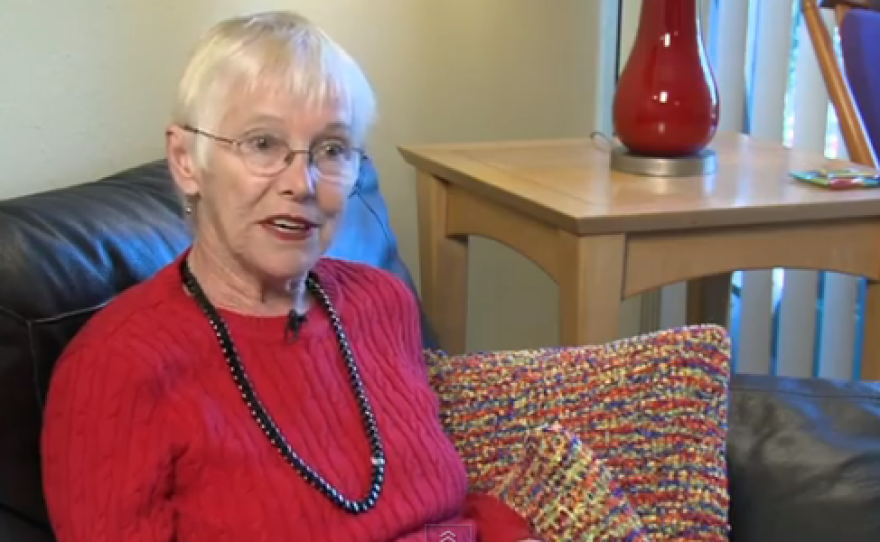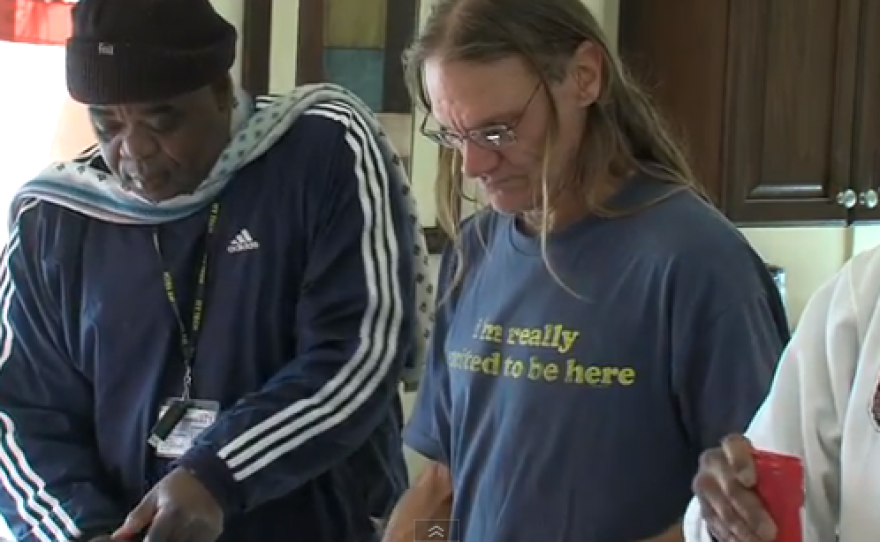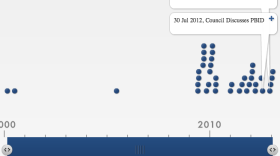In June 2009, a group of downtown San Diego residents discovered the city had been overcharging them on part of their property taxes—sometimes by thousands of dollars.
One of the residents is Kathy Casey. The 72-year-old has been fighting the city for a long time to get that money back.
“It’s been three and a half years and to date no one’s been paid back a cent," she said. “I estimate 3,000 home owners were overcharged to the tune of about $300,000.”
City of San Diego officials agree people have been overcharged. But they haven’t yet refunded anybody.
Property owners in the Core, Columbia, Marina, Gaslamp Quarter, East Village and Cortez neighborhoods of downtown San Diego pay an extra fee for something called a Property and Business Improvement District, or PBID. PBIDs provide additional services the city doesn’t, like palm tree trimming and sidewalk cleaning. The amount downtown residents pay is based on the size of their properties.
Problem is, their property sizes were calculated incorrectly. These mistakes were first covered in the San Diego Reader in 2010 and by this reporter in a story for Voice of San Diego in 2011.
Discovering these errors took a bit of detective work by the downtown property owners. Rita Collier, the head of a Cortez neighborhood association, was the first to question the PBID fees listed on her property tax bill back in 2009. Although the PBID fee is based on the size of her property, her property size wasn’t listed on the bill.
Collier contacted the Downtown San Diego Partnership, the nonprofit organization contracted by the city to oversee the PBID and decide how the fees are spent. They gave her something called an assessment roll, which lists every downtown property with its calculated size.
Looking at the list, Collier saw her property was too big. She told Casey and some other downtown residents to look as well, and they found their properties were also too big.

“Thirty-eight of the 54 properties had been overcharged,” Casey said about the condos in her building. “Further checking, we found out that all the condominiums in the city built before 2005 had incorrect assessments.”
The downtown PBID program started in 2000, and it appears that at first there were no mistakes. But when the program was renewed in 2005, the city hired a new engineering firm. This new firm, SCI Consulting Group, used a different method for calculating property sizes. That means the mistakes likely started in 2005.
A comparison of property size lists (or assessment rolls) between 2005, when the city hired SCI, and 2010, after the mistakes came to light, shows 2,747 properties were listed as bigger in 2005 than in 2010. This is somewhat unusual, because buildings don’t usually get smaller over time. If all of those property shrinkages reflect mistakes, than the city could have collected $340,353 more in PBID fees than it should.
City Council President Todd Gloria said the city has different numbers, but said they can’t yet be made public because of ongoing litigation with SCI (more on that later).
After discovering the errors in 2009, Collier emailed Luis Ojeda, the program manager of the city’s Economic Development Division. He responded by acknowledging the mistakes and blaming them on SCI. Ojeda also said everyone would get refunds.
“I already have SCI's assurances that this issue has been corrected for FY 2009-10 and we will also correct the previous years if they were incorrectly assessed,” Ojeda wrote in an email to Collier. “Typically under this type of circumstances [sic] we either issue a refund check to the property owners or apply a credit towards the following assessment year. I will also try to ensure that the other property owners need not file an appeal as we will work making any corrections.”
Months passed. No refunds came. Casey continued asking city officials to fix the problem.
When she contacted Ojeda again in September 2009, his response was less promising. He said he would “honor my word” and refund anyone who had submitted a claim, but only for that year. Because the overcharges began in 2005, Casey found this answer unacceptable.
She continued her fight. For the next year and a half, Casey was passed from branch to branch of the city government. She contacted City Councilman Kevin Faulconer, who represented downtown at the time, the city attorney’s office, the city’s risk management department, Mayor Jerry Sanders and Kris Michell, the president of the Downtown San Diego Partnership.
In January 2010, Ojeda told Casey to file a claim with the Office of Risk Management. A month later, that was claim denied because it was not filed within six months of the incident. If Casey had been told to file the claim when she first discovered the errors in June 2009, perhaps at least that year’s overcharges would have been refunded.

The city took its blame of SCI to the courtroom in June 2011, when it filed a lawsuit against the engineering firm for breach of contract. City officials told Casey she might have to wait for that lawsuit to be settled before getting her money back.
One month later, the City Council discussed the overcharges. Faulconer said city staff was going through the mistakes. Then property owners would be refunded.
“We want the right rules of the road,” he said at that July 26, 2011 meeting. “We want it to be fair for everybody. And so if it wasn’t fair in the past, I want to know what that amount was so we can have it back here to take action to make people whole.”
More time passed. Nothing happened.
One property that was overcharged could use the money: Safe Haven, a homeless shelter for the mentally ill. Lesslie Keller, the executive director there, said the shelter was listed at four times its actual size, costing it about $7,000 in extra PBID fees.
“We need to raise money for this program and every penny counts,” Keller said. “We are able to add advantages that enhance the services we provide whenever we have additional funds.”
That extra money could go toward helping people like John Scarborough, a diagnosed schizophrenic who was homeless until he came to Safe Haven four months ago.

“To me it’s a lifesaver, because I was on the verge of committing suicide,” Scarborough said. “I mean I was at my last end, my rope, I was just totally fed up with everything.”
Safe Haven can house 28 people at a time, and provides them with counseling, rehab and job training while they get back on their feet. Keller said it successfully transfers about 75 percent of its residents to permanent housing.
Just last month, the city finally agreed to do something that could help some downtown residents get their money back. Gloria, the City Council president who now also represents downtown, said the city will refund property owners.
But, there’s a catch. There’s a four-year statute of limitations on claims made against the city. So if property owners file claims now, they will only be refunded back through about 2008, even though the overcharges started in 2005.
That means only Casey and the 100 or so people she alerted to the problem will get their full refunds. As for Safe Haven, no one from the city told them to file a claim until now, so they probably won’t get all their money back.
Gloria said he understands the argument that people should be refunded more, but he thinks what the city is doing is fair.
“I think it’s fair for the city to pay back what we’re required to pay back, and that is exactly what we’re doing,” Gloria said. “The more important piece for me and my colleagues on City Council is we don’t have these kind of mistakes again.”
If property owners had known about the overcharges back in 2009, they all could have filed claims then and gotten their full refunds. Gloria said he doesn’t know what the city did to get the word out back then, and concedes that the mistakes were not clearly visible on people’s tax bills.
“I would hope that they would pay close enough attention to their property tax bill, but even if they did, they wouldn’t know to such a specific level that they were being over or undercharged,” he said.
Gloria said he’s working to get the word out now. He also said the city will never hire SCI as an engineer again.
“Because I believe in assessment districts, and I know how important they are for neighborhood revitalization, we cannot allow one bad apple to really ruin what is obviously a successful program,” he said.
When SCI was asked to comment on the city’s claims, its lawyer sent a statement saying the blame has been placed unfairly.
“Neither the public nor the media has heard all of the facts, and the claim that square footages were miscalculated by SCI is inaccurate,” the statement said. “SCI is confident that once it presents the evidence regarding its work on the Downtown PBID, it will be exonerated.”
Requests for comment from the Downtown San Diego Partnership, Ojeda and Mayor Bob Filner were not answered. Councilman Faulconer's staff said he could not comment because of the ongoing lawsuit.
As Casey sat in the immaculate living room of her downtown condo, where she’s lived for the past seven years, she conceded that she is only owed about $100 in refunds. But, she said, she’s continuing this fight on the part of people who don’t have the time or resources to demand their money themselves.
“The federal government, the state government, the county government, when there are errors that occur, they are able to refund in a timely manner,” she said. “Why didn’t the city? So I’m hoping that something will happen.”
Even after three and a half years entangled in the city’s bureaucratic machine, she somehow remains optimistic that everyone will get refunds.
“I have hope,” she said. “I think it would be the ethical thing to do.”







